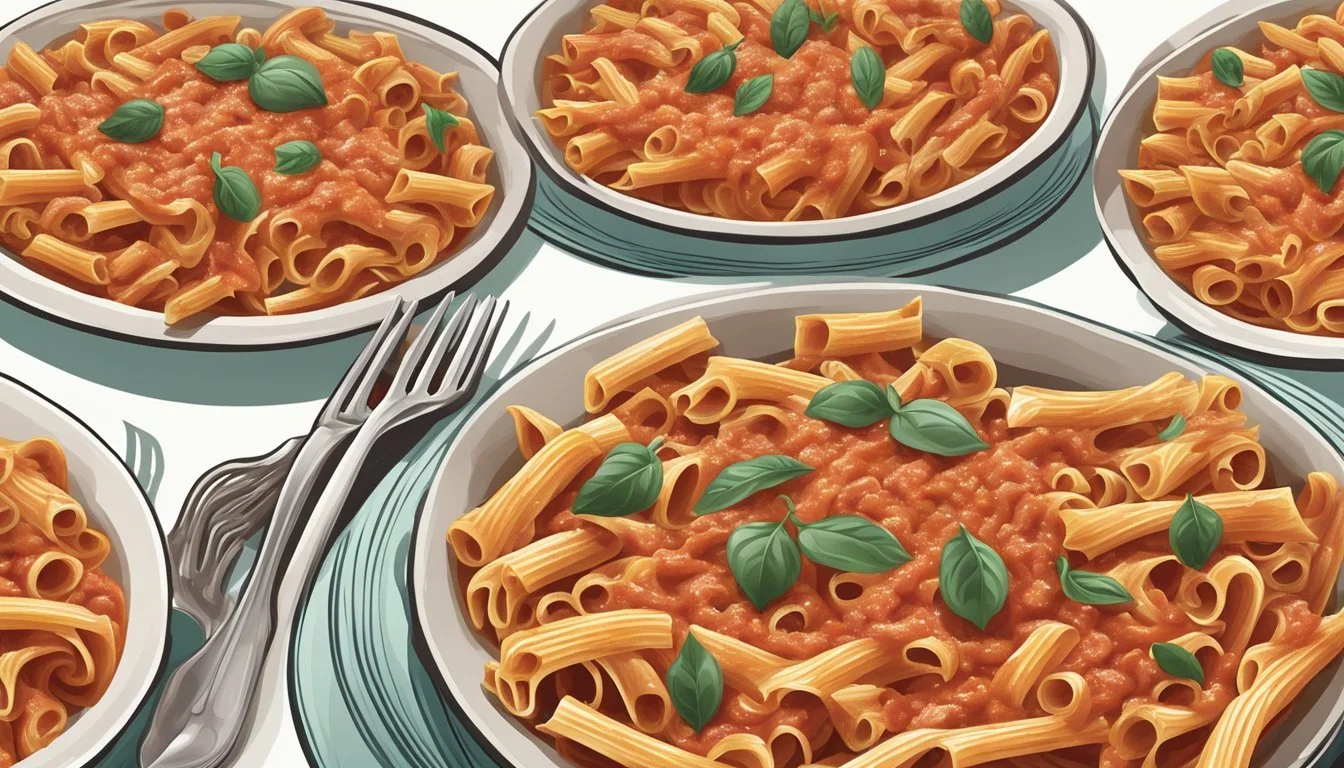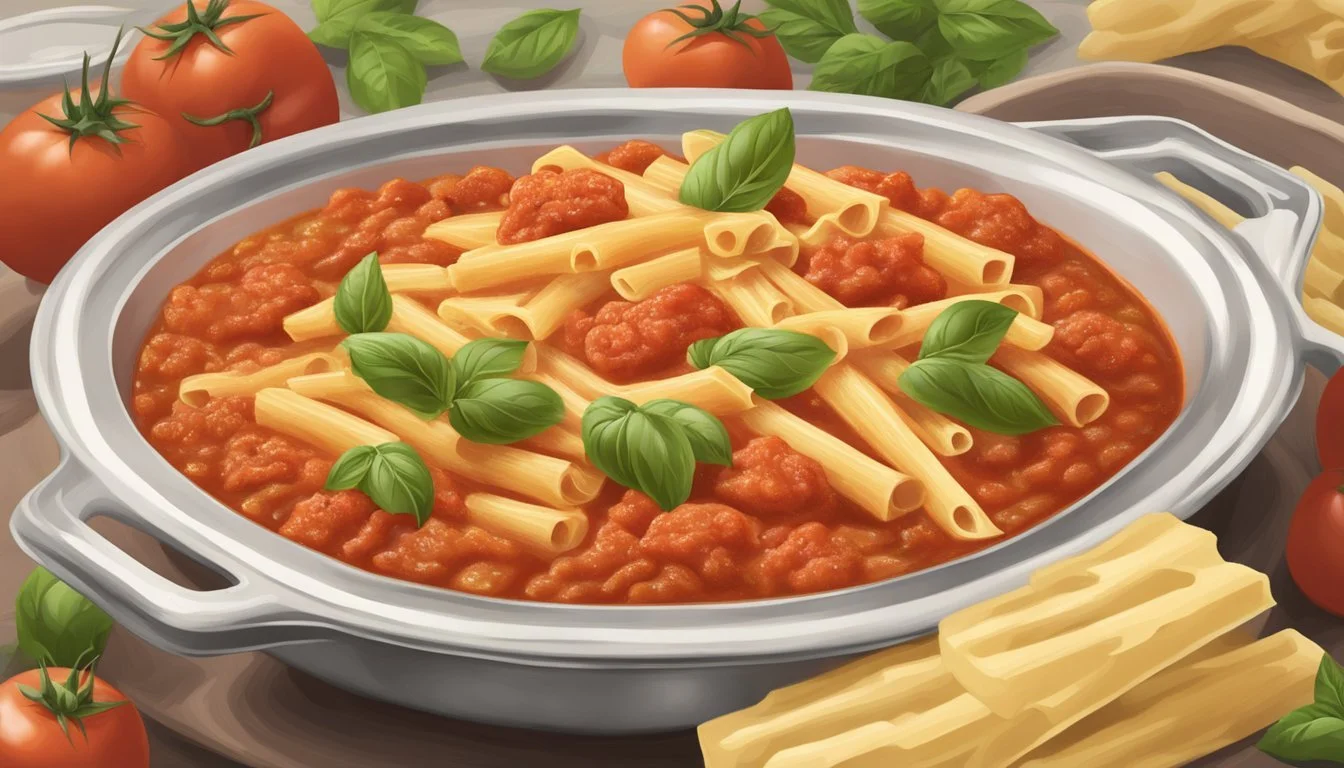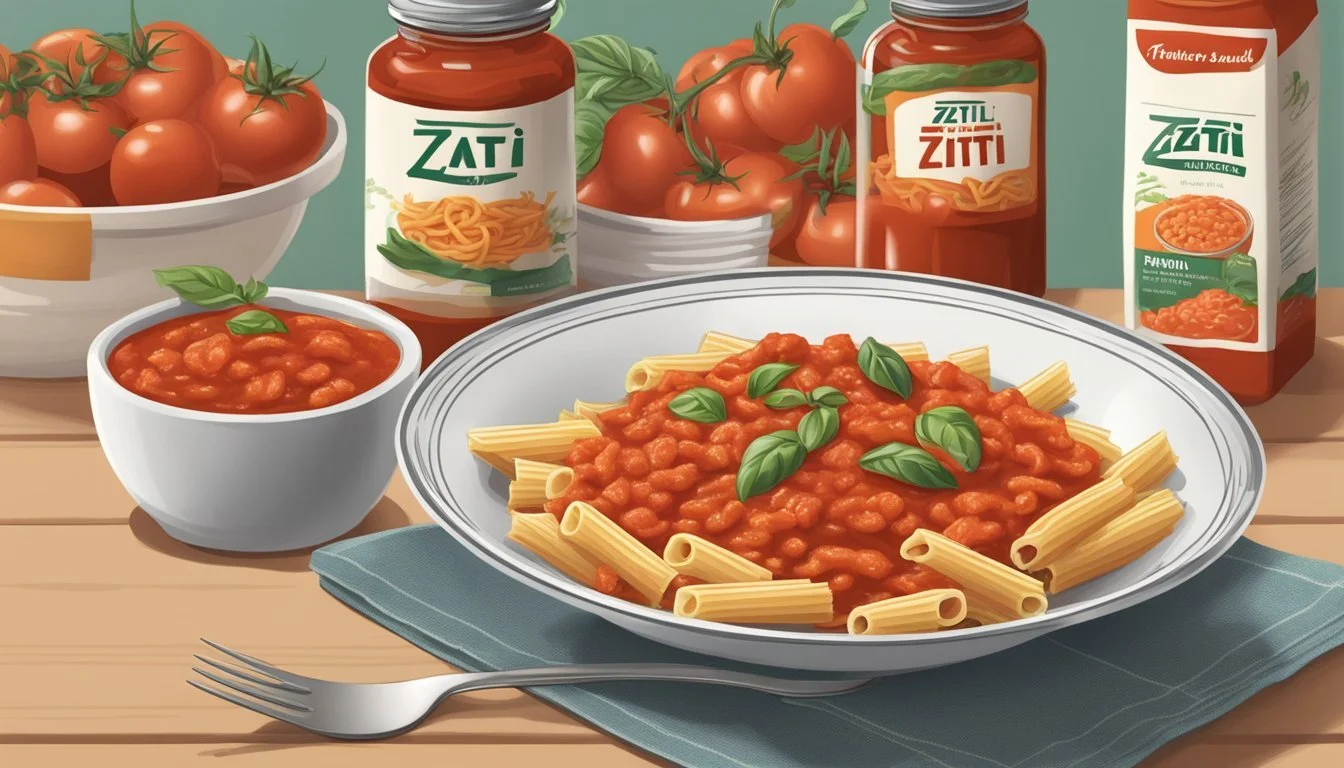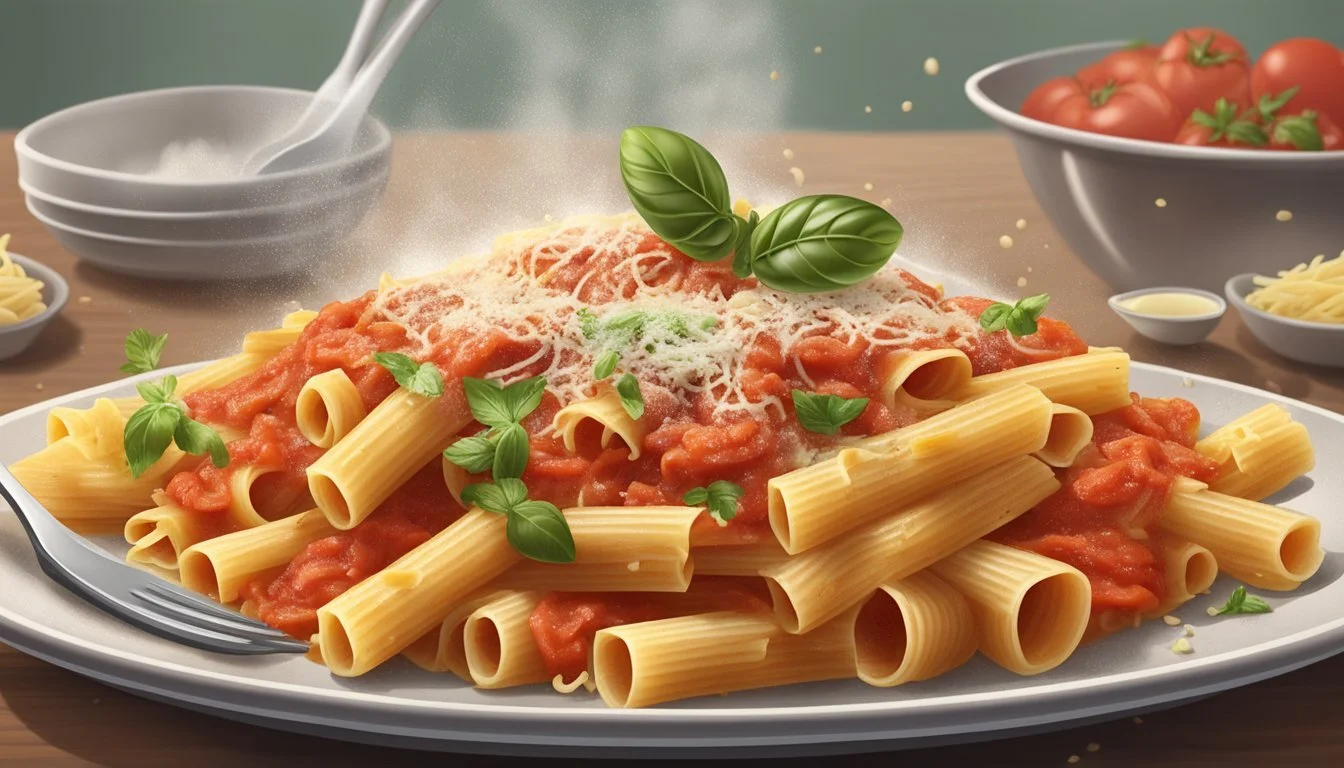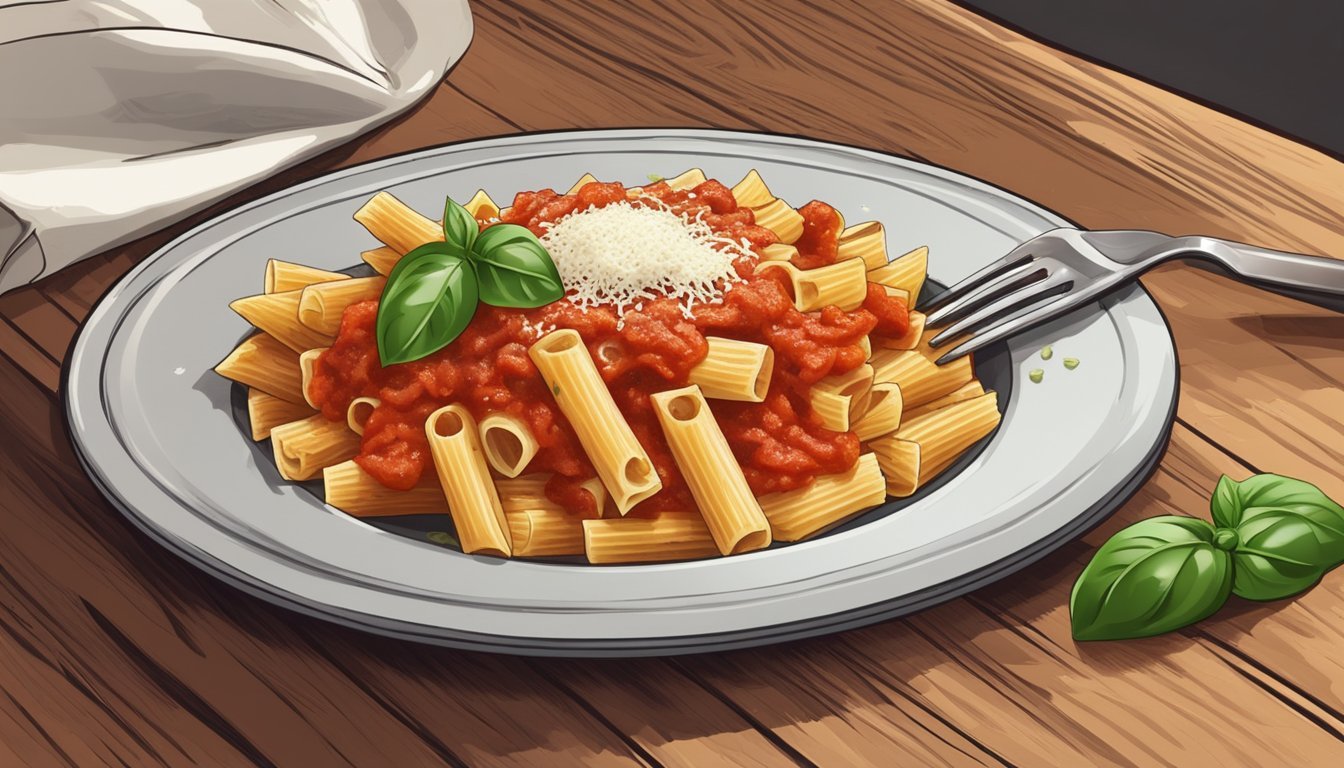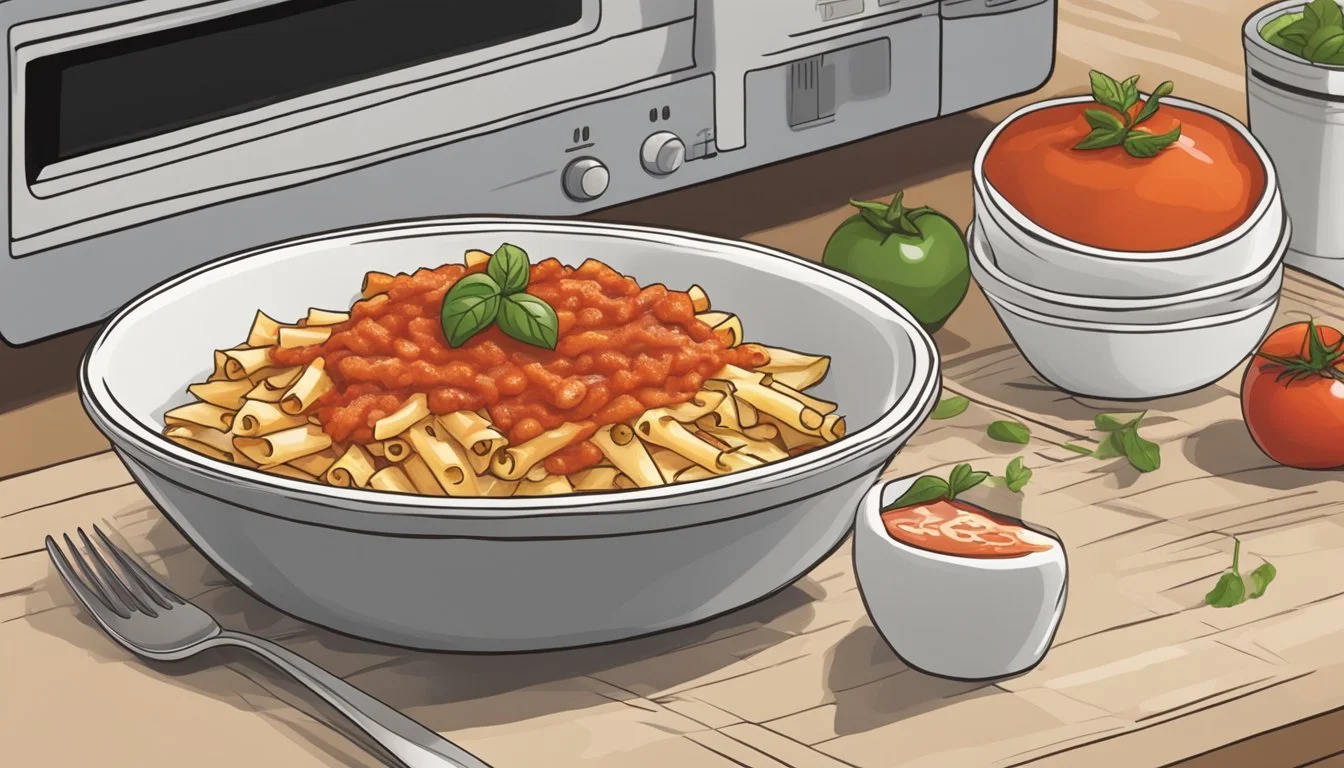How Do You Eat Ziti with Marinara Sauce?
Mastering the Art of Italian Dining
Eating ziti with marinara sauce is a delightful experience that combines the satisfying textures and flavors of Italian cuisine. Ziti, a type of pasta (What wine goes well with pasta?) that is best known for its tubular shape and smooth surface, serves as an excellent base for the rich and herby marinara sauce. This classic combination ensures each bite is infused with the tanginess of tomatoes complemented by the subtle blend of herbs and spices found in the sauce.
When serving ziti with marinara sauce, one typically looks for the pasta to be cooked to al dente perfection. The term 'al dente' refers to pasta that is cooked until it is firm to the bite, which is crucial for holding up against the robust marinara sauce without becoming too soft or mushy. The sauce itself, often a simmered concoction of tomatoes, garlic, onions, and a mix of Italian herbs such as basil and oregano, clings to the smooth ziti, providing a zesty and slightly sweet coating to the pasta.
This Italian staple is more than just a comfort food; it's a versatile dish that can be effortlessly adapted to various tastes and preferences. Whether it's topped with a sprinkling of cheese, accompanied by a protein like chicken or beef, or enjoyed as a simple vegetarian main, ziti with marinara sauce remains a popular choice for both quick weeknight meals and elaborate gatherings. The key to its enjoyment lies in marrying the textures and flavors in harmonious proportions, ensuring that each forkful is as enjoyable as the last.
Basics of Pasta
When it comes to pasta, understanding the wide variety of shapes and choosing the appropriate type for a specific sauce can elevate a simple meal to a satisfying culinary experience.
Pasta Varieties
Pasta comes in numerous shapes and sizes, each suited to different types of dishes. Ziti pasta, recognized for its medium-sized tubular shape, is an excellent choice for baked pasta dishes where its tubes fill with sauce and cheese. Other tubular pastas include penne, with its angled ends, and rigatoni, which is larger with ridges on the surface. These ridges and holes are adept at trapping and holding sauces. Then, there is spaghetti, a long, thin pasta that pairs well with lighter sauces, allowing them to coat each strand evenly.
Tubular Pastas Characteristics Ziti Medium-sized, smooth, tube shape Penne Medium-sized, angled ends, can have ridges (penne rigate) Rigatoni Large, ridges, wide tubes
Choosing the Right Pasta
Selecting the right pasta shape can depend on the sauce. Thick, robust sauces like marinara cling well to the grooves and hollows of tubular pastas such as ziti, penne, or rigatoni. These shapes allow the sauce to adhere to the pasta, creating a balanced bite. For lighter, thinner sauces, it's often suggested to go with long, thin pasta shapes like spaghetti, which allow the sauce to cover more surface area. It's important to match the pasta with the sauce to ensure that each forkful is harmonious in flavor and texture.
Ingredients Overview
When crafting a dish of ziti with marinara sauce, the quality and choice of ingredients play pivotal roles in defining its flavor and texture. A careful selection of pasta, cheeses, and a robust marinara sauce punctuated with the right seasonings can enrich the eating experience.
Key Ingredients
Pasta: For this dish, ziti is the pasta of choice, offering a good surface for sauces and cheeses to cling to.
Marinara Sauce: A classic marinara sauce, with a tomato base, sets the foundation for the dish's flavor profile. It typically consists of tomatoes, garlic, onions, and sometimes a hint of wine.
Cheeses: A combination of cheeses provides both flavor and a creamy texture. The dish often includes:
Mozzarella Cheese: Offers a delightful stretch and mild taste.
Parmesan Cheese: Brings a nutty and salty flavor that complements the tomato sauce.
Ricotta Cheese (optional): Adds a creamy texture and a slightly sweet flavor.
Seasoning and Spices
Garlic: Essential for infusing the marinara sauce with a pungent, aromatic flavor.
Fresh Basil: Lends a sweet and peppery flavor, enhancing the marinara.
Salt and Pepper: Fundamental seasonings for balancing and enhancing the overall taste.
Oregano: Offers an earthy, slightly bitter and aromatic component.
Parsley: Generally used as a garnish, adding a fresh, clean flavor to the finished dish.
Olive Oil: Used for sautéing, it contributes to the richness of the sauce.
Preparation Techniques
To create a satisfying dish of ziti with marinara sauce, one must focus on two crucial steps: perfectly cooking the pasta and crafting a flavorful sauce. Mastery of these techniques ensures a dish that is both authentic in texture and rich in taste.
Pre-Cooking Pasta
Cooking the pasta to an al dente texture is essential; it should be firm to the bite. To achieve this:
Preheat the oven, if baking is required post-assembly, to the temperature specified in the recipe (commonly between 350°F and 400°F).
Fill a large pot with water and bring to a rolling boil. Add a generous amount of salt to the water, as this is the only chance to season the pasta itself.
Add the ziti to the boiling water and stir occasionally to prevent sticking.
Cook the pasta until it is al dente, usually a minute or two less than the package’s recommended cooking time.
Sauce Making
The marinara sauce acts as the heart of the dish and requires attention to detail:
Begin by selecting high-quality tomatoes, as they form the base of the marinara sauce.
In a saucepan, heat a drizzle of olive oil and gently sauté finely chopped garlic and onions until they are translucent.
To the sautéed aromatics, add crushed tomatoes, and if desired, tomato paste for thickness and depth.
Season the sauce with salt, pepper, and Italian herbs, and let it simmer until it develops a rich flavor and consistency. This may take approximately 20 to 30 minutes.
Once the sauce is ready, one can either mix it with the pasta before serving or ladle it over the top.
Assembly and Baking
Assembling baked ziti is a straightforward process that involves layering the components before baking them to perfection. This section guides the reader through the crucial steps to create a satisfying casserole that can become a family favorite.
Layering Components
In a well-oiled 9x13-inch baking dish, initiate the layering by spreading a thin layer of marinara sauce on the bottom. Follow with a layer of cooked ziti pasta, ensuring an even distribution. Sprinkle generously with cubed mozzarella and grated Parmesan cheese, creating a rich and flavorful profile. Repeat these layers until all ingredients are utilized, usually finishing with a final layer of cheese. This layering technique ensures every serving is packed with cheesy goodness and robust marinara flavor.
Baking Time and Temperature
Before baking, preheat the oven to a temperature of 400°F. The casserole should heat through and the cheeses should melt to create a golden-brown crust, indicative of a perfectly baked ziti. This typically takes about 25-30 minutes. To ensure the pasta dish reaches optimal texture and warmth, one may cover the dish with foil for the initial baking period and remove it towards the end for the cheese to develop a desirable crispy top layer. The result is an easy, baked pasta classic that satisfies with each bite.
Accompaniments and Variations
When enjoying ziti with marinara sauce, diners can enhance their meal with a variety of meats or vegetarian options, as well as complementary side dishes. These additions offer a complete dining experience that caters to diverse tastes and preferences.
Meat and Vegetarian Options
Meat Additions:
Sausage: Ziti pairs well with Italian sausage, which provides a spicy and savory flavor.
Meatballs: Classic beef or pork meatballs complement the marinara sauce's tanginess.
Chicken Parmesan (What wine goes well with chicken parmesan?): Serving ziti with a side of chicken parmesan can elevate the meal to a hearty feast.
Vegetarian Alternatives:
Vegetarians might opt for zucchini, mushrooms, or eggplant as substantial additions.
These vegetables can be sautéed and mixed into the sauce or served as a separate component to maintain their distinct texture.
Sides and Pairings
Salad and Bread:
A green salad, dressed with a light vinaigrette, offers a refreshing contrast to the robust pasta dish.
Garlic bread, with its crispy edges and aromatic flavor, is a staple alongside ziti, perfect for mopping up extra sauce.
Vegetable Side Dishes:
Steamed or grilled vegetables like asparagus or broccoli provide a nutritious and flavorful balance to the meal.
For a creative touch, roasted strips of bell peppers add a sweet and smoky note to the overall dish.
Each component should be selected to complement the rich tomato-based marinara and the pasta’s al dente texture. These variations allow for a customized meal that can suit any dietary preference while maintaining the classic appeal of ziti with marinara sauce.
Serving Suggestions
When serving ziti with marinara sauce, the dish is best presented hot to ensure that the cheese is melted and stringy. It's a hearty pasta dish that exemplifies the comforts of a home-cooked meal, with its rich blend of cheesy goodness, robust marinara, and al dente pasta.
Cheese: A generous topping of shredded mozzarella and a sprinkle of Parmesan can be added before baking to create a deliciously golden and gooey cheese layer on top. For additional creaminess, dollops of ricotta cheese may be swirled into the ziti before baking.
Herbs: Freshly chopped basil or parsley make for a flavorful garnish, adding a burst of freshness to balance the rich flavors.
Bread: A side of crusty garlic bread or breadsticks complements the saucy nature of the dish, providing a delightful crunch and a way to mop up extra sauce.
Salad: Offering a side of light green salad with a simple vinaigrette offsets the dish's filling qualities and adds a crisp texture contrast.
Ingredient Purpose Mozzarella Cheesy layer Parmesan Flavor boost Ricotta Creaminess Basil Fresh garnish Garlic Bread Crunchy side
It is important to layer the ingredients evenly when assembling the ziti to ensure that each serving is equally saucy and includes a blend of the cheeses used. This ensures that every bite is as comforting and satisfying as the last.
Storage and Reheating
Proper storage and reheating techniques are essential for enjoying leftover baked ziti with marinara sauce while maintaining its flavor and texture. This section covers the best practices for refrigerating ziti and methods to reheat it, ensuring your meal remains delicious.
Refrigeration Best Practices
When storing leftover baked ziti, one should cool it to room temperature before refrigerating to prevent bacterial growth. In an airtight container, leftovers will keep their quality for up to 5 days. If the intent is to keep the ziti for a longer duration, freezing is the better option. In the freezer, baked ziti can be stored effectively for up to 2 months. To prepare baked ziti for freezing, one should portion the ziti into manageable servings, wrap it tightly in plastic wrap, and then cover it in aluminum foil or place it inside a freezer-safe bag.
Reheating for Quality
The reheating process is crucial in reviving the baked ziti's taste and texture. When reheating, one can employ different methods, such as using an oven or microwave. For reheating in the oven:
Preheat to 350°F (177°C).
Transfer the ziti to an oven-safe dish if it's not already in one.
Add a little marinara sauce on top to moisten it.
Cover with aluminum foil to prevent drying.
Heat for about 30 minutes; if frozen, extend the time to 45 minutes or until heated through.
For quick reheating, the microwave can be used, especially for defrosting and reheating frozen ziti:
Cover the ziti with a microwave-safe lid or microwave-safe plastic wrap.
Use the defrost setting for approximately 5 minutes if the ziti is frozen.
Then, heat on high for 5 minutes, checking and stirring every minute to ensure even heating.
These simple and easy recipes for reheating ensure that every bite of the baked ziti with marinara sauce retains its rich flavor and inviting texture.
Health and Dietary Information
When incorporating ziti with marinara sauce into a diet, individuals should consider the nutritional content alongside their dietary restrictions and preferences. A standard 1/2 cup serving of marinara sauce typically contains:
Calories: 66
Protein: 2 grams
Fat: 2 grams
Carbohydrates: 10 grams
Sodium: 577 mg
Ziti pasta, traditionally made from wheat, is a source of gluten. Those with celiac disease or a gluten sensitivity may opt for gluten-free pasta as an alternative, which is made from alternative grains like rice or corn.
When preparing ziti with marinara sauce, a variety of cheese options are available. For a richer flavor, some recipes recommend using whole-milk ricotta cheese, which contains dairy and could contribute to higher fat content. Those with lactose intolerance or a vegan diet might seek plant-based cheese replacements.
The table below summarizes the options for some common dietary concerns:
Concern Option Gluten sensitivity Choose gluten-free pasta Dairy avoidance Use plant-based cheese Calorie-conscious Limit cheese and oil portions
One must also consider the overall balance of a meal with ziti and marinara. Pairing the dish with vegetables can provide fiber and vitamins while keeping the meal more nutritionally diversified. It's vital to address these dietary components to maintain a well-rounded and health-conscious diet.
Practical Tips and Tricks
When preparing ziti with marinara sauce, one focuses on streamlining the cooking process and infusing the dish with unique flavors. By following these practical tips and tricks, an individual can enjoy a hearty and scrumptious meal that's perfect for any day of the week.
Efficiency in Preparation
Plan Ahead: To make ziti with marinara sauce an easy weeknight dinner, one should plan ahead. Preparing the marinara sauce ahead of time allows for a quick assembly. For even more convenience, one can opt for using a slow cooker to simmer the sauce, which infuses it with flavor without needing constant attention.
Ingredient Prep: Chop any vegetables and measure out your ingredients such as dried Italian seasoning before you begin cooking to save time.
Cook in Batches: If one is expecting to serve ziti at a potluck or needs multiple meals through the week, it's advisable to cook pasta in large quantities. Ziti can be kept al dente and refrigerated until needed.
Fast-Track Cooking: Utilize a large pot for boiling pasta to reduce cooking time and always salt the water for flavor. When preparing marinara sauce, use canned tomatoes to cut down on prep time without sacrificing quality.
Creative Twists
Experiment with Ingredients: To elevate the dish, one may incorporate heavy cream into the marinara sauce for a richer, creamier profile. For added convenience, consider preparing pasta bakes; they can be assembled in advance and baked when ready to eat.
Personalize with Produce: Adding sautéed vegetables like bell peppers or mushrooms can introduce a new dimension to the flavor profile.
Disposable Convenience: For easy cleanup, especially when preparing a dish for a potluck, using a disposable aluminum pan can be particularly practical. This not only makes transportation easier but also means no dishes to wash after the event.
Herb Enhancements: To further embolden the dish, a sprinkle of additional dried Italian seasoning before baking can intensify the aromatic experience.
Alternative Cooking Methods
When preparing ziti with marinara sauce, there are several alternative cooking methods that can adapt the Italian-American classic to different tastes, dietary needs or appliances at hand.
Pasta Bake Variation: Ziti can be assembled as a pasta bake, an excellent option for a make-ahead meal. First, partially cook the ziti until it's al dente. Then, toss the pasta in a baking dish with marinara sauce, layering or mixing with cheese and other ingredients as desired. One might choose to integrate ground turkey for a leaner protein option, combining it with the red sauce to enhance the flavors. Finish by baking in a preheated oven until bubbly and golden on top.
Broiling Technique: To add a textured, crispy cheese crust to the pasta bake, one can utilize the broiler for the last few minutes of cooking. Monitor closely, as the high heat can quickly turn from perfectly golden to burnt.
Slow Cooker Approach: For convenience, a slow cooker can be used to bring together the ziti and marinara sauce. This method is especially useful for ragu-style sauces that benefit from long, slow cooking to develop depth of flavor. Layer the ingredients in the slow cooker and cook on low heat, ensuring the pasta does not become too soft.
Cooking Method Main Benefit Key Consideration Pasta Bake Make-ahead convenience Avoid overcooking pasta Broil Crispy cheese topping Broil with care to avoid burning Slow Cooker Flavor development in sauce Prevent pasta from becoming mushy
Each of these methods offers a nuanced variation to enjoying ziti with marinara sauce, ranging from time-saving options to methods that enhance flavor or texture.

